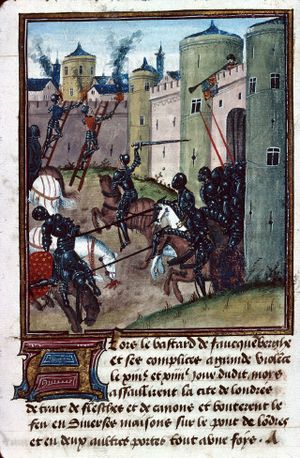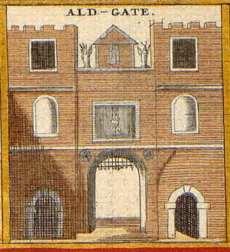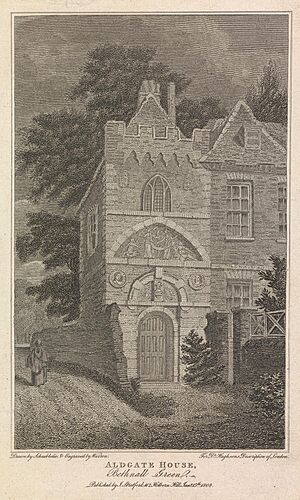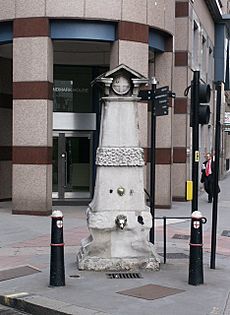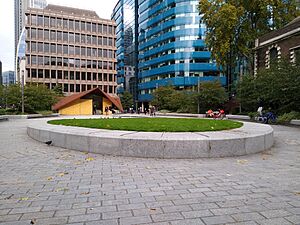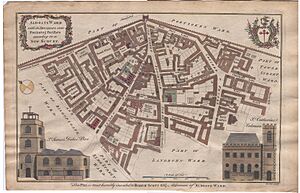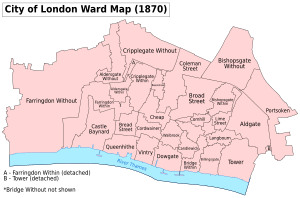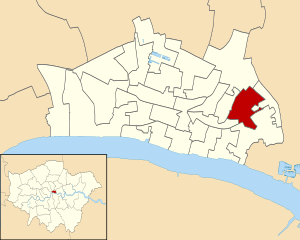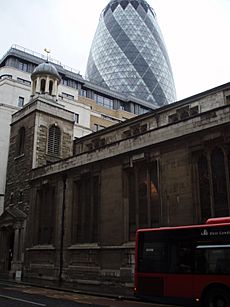Aldgate facts for kids
Quick facts for kids Ward of Aldgate |
|
|---|---|
 Print of the Aldgate, around 1609 |
|
| OS grid reference | TQ334813 |
| • Charing Cross | 2.3 mi (3.7 km) WSW |
| Sui generis | |
| Administrative area | Greater London |
| Region | |
| Country | England |
| Sovereign state | United Kingdom |
| Post town | LONDON |
| Postcode district | EC3 |
| Postcode district | E1 |
| Dialling code | 020 |
| Police | City of London |
| Fire | London |
| Ambulance | London |
| EU Parliament | London |
| UK Parliament |
|
| London Assembly | |
Aldgate was once an important gate in the old defensive wall that protected the City of London. This gate gave its name to Aldgate High Street, which is the start of the A11 road. This road goes through an old area called Portsoken Ward, just outside the city wall.
Even though there's also an Aldgate Ward inside the old wall, when people say "Aldgate" today, they usually mean the area around Aldgate High Street in Portsoken Ward. This area is about 2.3 miles (3.7 km) east of Charing Cross.
Contents
All About Aldgate
Aldgate is a historic area in London, known for its past as a city gate. It has a rich history, from Roman times to today.
What Does Aldgate Mean?
The exact meaning of the name "Aldgate" is a bit of a mystery. It was first written down in 1052 as Æst geat, which meant "east gate". By 1108, it had changed to Alegate.
Some people think it means "Old Gate" (Aeld Gate). Others suggest it could mean "Ale Gate" (perhaps because of an old pub) or "All Gate", meaning it was open to everyone. Historians are still discussing the true origin of the name.
The Old Gate Itself
It's believed that a gate stood at Aldgate during the Roman period. This was when the London Wall was first built. This early gate likely had two round towers. It was located where Duke's Place is today, on the east side of the city. A busy road passed right through it.
The gate was rebuilt several times over the centuries. It was rebuilt between 1108 and 1147, and again in 1215. A big reconstruction happened between 1607 and 1609. This time, it was made to look more fancy and less like a fort.
In 1377, Aldgate and other London gates were made stronger with special gates called portcullises and chains. This was because people were worried about attacks from the French.
Aldgate's Defenses in Action
Aldgate's defenses were tested twice in history.
- In 1381, during the Great Rising, thousands of rebels entered the City through Aldgate. They were helped by people inside and outside the city.
- In 1471, during the Siege of London, soldiers led by the Bastard of Fauconberg forced their way through the gate. However, they were trapped and defeated in the small space just inside.
Some historians think that Aldgate's defenders might have let a few of Fauconberg's men through on purpose. This would allow them to quickly drop the portcullis. This way, they could trap and defeat a small group of attackers at a time.
Geoffrey Chaucer at Aldgate
From 1374 to 1386, the famous writer Geoffrey Chaucer lived in rooms above the gate. He was working as a customs official at the time. He wrote some of his poems while living there.
The rooms above the city gates were often rented out. They were in great locations but were not very comfortable. They were built for soldiers, so they were rough and not very private. Chaucer's room was probably small, cold, and didn't have good lighting.
In 1598, John Stow wrote that Aldgate used to have two sets of gates and two portcullises. By his time, only one of each remained.
The Gate is Removed
The Aldgate was taken down in 1761. This was done to help traffic flow better through the busy area. A local history lover named Ebenezer Mussell bought some of the gate's stones and decorations. He used them to make his house in Bethnal Green bigger. He even renamed his house Aldgate House. This house was later taken down between 1807 and 1811 for new buildings.
Aldgate Today
The area known as Aldgate today is mainly around Aldgate High Street. This street was once part of a Roman road called the Great Essex Road. The Aldgate Pump, which is just inside where the old gate used to be, is also part of the Aldgate area.
Just east of Aldgate High Street, the road changes its name to Whitechapel High Street. This area is part of Whitechapel. Sometimes, people include the part of Whitechapel High Street near Aldgate East tube station as part of Aldgate too.
A Look at Aldgate's Past
- The church of St Botolph's Aldgate has been standing near the old gate's spot since at least 1115.
- Around 1420, the Whitechapel Bell Foundry started in Aldgate. They made bells for churches, including the rebuilt St Botolph's church.
- In the late 1500s, a pottery workshop making special English Delftware was set up in Aldgate.
- A Jewish community grew in the area after Oliver Cromwell allowed Jews to return to England. They built London's oldest synagogue, Bevis Marks, in 1698.
- In 1773, the first book by an African American, Poems on Various Subjects, Religious and Moral by Phillis Wheatley, was published in Aldgate.
- Daniel Mendoza, a famous English boxing champion, was born in Aldgate in 1764.
Aldgate Pump
Since 1700, distances to places in Essex and Middlesex were measured from Aldgate Pump. The original pump was removed in 1876. A new, decorative pump and drinking fountain were put up nearby. This new pump gets its water from the New River.
Old records mention an "Alegate Well" next to the city wall. This might have been where the original pump got its water. You can still see parts of the old Holy Trinity Priory through a window in a nearby office building.
Aldgate Square
In the 1970s, the roads in central Aldgate were changed to create a large traffic circle. This led to new office buildings and underground walkways for people.
Aldgate Square is a new public space that opened in 2018. It's located between two historic buildings: The Aldgate School and the church of St Botolph without Aldgate. There's a cafe in the square called Portsoken Pavilion.
The path of the old London Wall is clearly marked by special paving on the western side of the square.
Public Artworks
You can find several interesting sculptures in Aldgate:
- "Ridirich" (1980) by Keith McCarter: a bronze abstract sculpture.
- "Sanctuary" (1985) by Naomi Blake: made of fibreglass, outside St Botolph without Aldgate church.
- "Column" (1995) by Richard Perry: a bronze column marking the entrance to Petticoat Lane Market.
- Six bronze horses (2015) by Hamish Mackie: in the piazza at Goodman's Fields.
Archaeological Discoveries
In 2013, archaeologists found an amazing 1,900-year-old Roman sculpture in Aldgate. It was discovered in what was once a Roman cemetery. This sculpture, called "The Minories Eagle", is considered one of the rarest and best finds ever in Britain. It shows a beautifully carved eagle holding a serpent in its beak. It was likely part of a grand tomb for a very important and rich person. The eagle was displayed at the Museum of London.
Ward of Aldgate
Aldgate is one of 25 wards in the City of London. Each ward chooses an Alderman and Commoners (like local council members) to help run the City of London Corporation. Only people who are Freemen of the City can run for these positions.
The wards of London probably started forming around the 11th century. Their main purpose was for administration, justice, and defense. Wards like Aldgate, which had a gate, were especially important for protecting that gate, as gates were often the weakest points in the city's defenses.
The historic Aldgate ward was bordered on the east by the old London Wall, near Houndsditch. This wall separated it from the Portsoken ward.
Since 2013, the ward's boundaries have changed. It now includes areas like White Kennet Street in the north and Crutched Friars in the south. It also takes in parts of Leadenhall and Fenchurch Streets. This means it now includes a small area that was once outside the old city walls.
The Augustinians priory of Holy Trinity Aldgate was founded in 1108 by Matilda, the wife of King Henry I. It was built just inside the gate.
From 1181, Jews lived in Aldgate ward, north of the gate. They were later forced to leave in 1290 by King Edward I. This area became known as Old Jewry. When Oliver Cromwell welcomed Jews back to England, they settled in the area again. They founded London's oldest synagogue, Bevis Marks, in 1698.
Today, the ward is a major center for the insurance industry. Many insurance companies and brokers are based here. Important buildings include the Lloyd's Register building, 30 St Mary Axe (also known as "The Gherkin"), the Willis Building, and the London Metal Exchange.
Three churches are located in Aldgate ward:
- St. Botolph's
- St Katharine Cree (built in 1631)
- St Andrew Undershaft (built in 1532)
The Bevis Marks Synagogue (built in 1699) is the oldest in the United Kingdom. It is also located in the ward, on Bevis Marks. John Cass's school is on the north side of Aldgate street. A plaque there shows where the old London Wall used to run.
Getting Around Aldgate
- The closest London Underground station is Aldgate. It's on the Circle and Metropolitan lines.
- Nearby, Aldgate East is served by the District and Hammersmith & City lines.
- Mainline train stations like Liverpool Street and Fenchurch Street are also close.
- Tower Gateway is the nearest Docklands Light Railway station.



